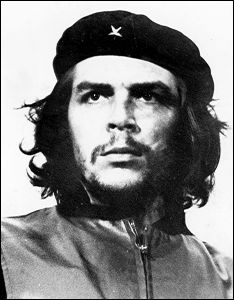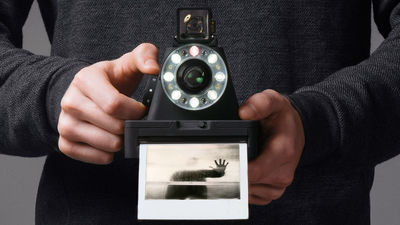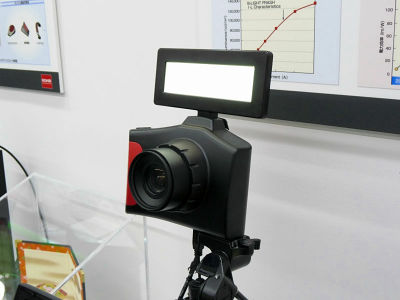The timeline that knows the successive model of "Leica M system" which celebrated the 60th anniversary of birth

A high-performance mechanism is built in a compact body, many users of professional photographers are using brands having a unique air feeling and presence, and it is also a brand of amateur spoilersLeica M System"Is celebrating its 60th anniversary since the birth of M3 aircraft in 1954. A timeline that looks back on the history of such M system is made public.
Leica M Timeline · I shoot film.
http://www.ishootfilm.org/timelines/leica-m

◆ Leica M3(1954 - 1966)
It is called one of the instruments of the range finder type camera using 35 mm filmM3Is a model announced in 1954 (Showa 29), the selling price in Japan at that time is a high-end machine with a super price of 290,000 yen. The lens mount is replaced with the previous screw typeBayonet mount(Leica M mount) was adopted, it can be said that it is a fate of the range finder typeparallax(Parallax) is very small, etc., and it gained popularity, and more than 220,000 units were produced in the model life of about 13 years.

◆ Leica M2(1957 - 1967)
Approximately three years after the M3 's debut M2 was a model planned as a simple version of M3 as a position. Due to its characteristics, it was often used as a wide-angle version of M3. In addition, the trigger type quick film winding device which could not be installed in the original M3 "Leica Bit MPFeatures that can be installed. Compared with the M3 hit, this model has been producing only 85,000 units in about 11 years.

By the way,Alberto CordaIs a famous portrait photo by Argentinean revolutionary Choi · GuevaraHeroic guerrillaThis model also shot.

ByWikipedia
◆ Leica M4(1967 - 1975)
The M4 which becomes the direct successor of M3 · M2 follows the specification automatically switching 35mm, 50mm, 90mm, 135mm finder frame according to the attached lens. A mechanism that automatically resets the film counter and returns to zero when the back cover is opened during film exchange is installed. Also, although it is hard to see in the picture, the film rewind crank located on the left hand part when setting the main body has been changed from horizontal to diagonally for convenience. Although the production of the model was terminated in 1972, it was reproduced in 1975, which is the 50th anniversary of Leica, as the successor M5 did not become popular. In 1977, a new model "M4-2" will be debuted as an improved version.

◆ Leica M5(1971 - 1975)
The M5 which appeared in 1971 adopted a design different from the neat taste until then, the body is larger and heavier than the predecessor. For that reason, in Japan, it became an unpopular model called "lunchbox" etc. In this model, the light after passing through the lens is measuredTTL exposure meterIn addition to being adopted, the exposure meter had a mechanism that can be checked by the finder.

◆ Leica M4-2(1977 - 1980)
As mentioned above, the popularity of M5 which became enlarged is not good, there is a situation that does not reach the achievement that the company assumed. As a result, Leica temporarily restored M4 as a 50th anniversary model in 1975, and in 1977 released M4 - 2, an improved version. Although the model name and body are followed, each part has been reviewed, the production process has also been updated and cost reduction is being done. From this model to the accessory shoeHot shoeHas been adopted, and a motorized Leica winder M4-2 for film winding mechanism is available, the self-timer function has been abolished.

◆ Leica M4-P(1981 - 1987)
Following M4 and M4-2, "M4-P", which is the third major update for the M4 series, debuted in 1981. In addition to the conventional 35 mm, 50 mm, 90 mm, and 135 mm, a finder frame for 28 mm and 75 mm lenses has been added, but also a critical opinion that "it is hard to see when wearing glasses" has also appeared.

◆ Leica M6(1984 - 1998)
M6 who inherited the trend of reviving the M4 series on behalf of the bad M5, abandoned the unpopular M5 design taste and followed the design of the M4 series despite the new model. However, the inside is a model that can be called "the orthodox evolution version of M4" as it is said that the latest technology is loaded. Lightweighting was done by adopting a magnesium alloy die-cast body instead of the conventional brass body, but there was a negative user in its light feeling. In addition, the exposure adjustment is done automatically from the next model 'M7'AEFunction is installed and the M6 series is the last manual exposure model.

ByAndrea Caligaris
◆ Leica M6 TTL(1998 - 2002)
M6 TTL is a model that is positioned as a minor model version of the previous M6, and the initial M6 is sometimes called "M6 classic" to distinguish it from this. Adjust the stroboscopic light amount automatically according to the result of photometryTTL flashA model corresponding to. Also, since the manufacturer's name was changed around this, the notation of the logo has been changed from "Leitz (rights)" to "Leica", which is one of the points to be referred to in distinguishing the model from the preceding and latter term I will.

◆ Leica M7(2002)
In the M7, the content changes drastically, the first electronic shutter in the M system is adopted, and the model equipped with the aperture priority priority auto exposure. Nevertheless, the shutter has a characteristic mechanism of having a conventional fabric shutter. The shutter button is of a two-step type, and it fixes the exposure with the first step of lightly pressing and the shutter goes down by pushing it further.

◆ Leica MP(March 2003)
Based on the M6 of one generation ago, the model which made the body knob design M3 tailored. The shape of the film feed lever and around the viewfinder has been changed. The model name "MP" is the initial letter of "Mechanical Perfection", which seems to mean mechanically completed M3.

◆ Leica M8(September 2006 - September 2009)
Although it is the camera of the M system which the electronic technology was fully adopted at the M7, it became M8 and finally stepped into the world of the digital camera. A 10.3 megapixel CCD "Kodak KAF 10500" of 18 mm × 27 mm (2: 3 2624 × 3936 pixels) is adopted as an image sensor. Although it is a digital camera, it seems to be said that the range finder formula is continued. High body magnesium alloy is used for the body, and the top and base parts are brushed off. It was a shameful model that there was a challenge in image quality, which is also called the first digital model, and in particular, the sensitivity to infrared light is too high, so the black object appears in purple because it is too high It was. Also, from this model the shutter has been changed from cloth to metal.

◆ Leica M8.2(September 2008 - September 2009)
A model that can be said as a version upgrade of the M8, a model in which countermeasures against the silence of the shutter sound were taken. As a result, the maximum shutter speed has been reduced from 1/8000 to 1/4000. Also, the model with the body color black was changed from the conventional plating finish to black painting.

◆ Leica M9(September 2009 - March 2013)
With the M9 which adopted 18.5 million pixels · 35 mm full size CCD for the image sensor, the conventional M mount lens can be used again, and past lens assets can be diverted. At that time it was the world's smallest full size CCD loaded model.

◆ Leica M9-P(June 2011 - March 2013)
In M9-P which becomes a highly durable version of M9, the liquid crystal cover glass is changed to sapphire glass, the red logo mark and the logo of "M9" on the front of the body are omitted and the logo of "Leica" on the top of the cover Design changes such as being placed are being made.

◆ Leica M Monochrom(May 2012)
M monochrome, which is a digital camera dedicated to monochrome shooting equipped with a 35 mm full size sensor, has no color filter in the sensor section. Therefore, the ISO minimum value is set 320 higher than M9 160, one step higher. It also features sharp imaging by capturing light more directly.

◆ Leica M-E(September 2012)
Model that emphasized simplicity by omitting the USB terminal and the frame selector lever of the viewfinder based on M9. Although it is the cheapest lineup in the M system, its price is still a high-end model that exceeds 600,000 yen indeed.

◆ Leica M(September 2012)
"M" which will be the successor of M9 is a model equipped with 24 mm pixel 35 mm full size CCD, it is the first movie shooting support model in the same series.

◆ Leica M-P(August 2014)
Model with 2 GB RAM capacity which is twice as large as "M", model with continuous shooting ability improved. The quality that sticks to high durability and detail is unchanged from the conventional one.

◆ Leica M - A(September 2014)
M - A introduced in the age of digital camera is a model that can be called the highest peak of a mechanical range finder camera that shoots with film. Not to mention the LCD monitor, of course, even the exposure meter is not mounted, it can be said that the camera's origin can be shot even without a battery, but that there are 100 years of Leica technology that has been cultivated for over 100 years about.

◆ Leica M Edition 60(September 2014)
"M Edition 60" announced to celebrate the 60th anniversary of the Leica M system is a digital camera, but it does not include a liquid crystal monitor, it features the minimum necessary functions for photography such as shutter speed, aperture, focusing, ISO sensitivity It is the world's first digital camera intended to concentrate on only. It is a model that can concentrate only on shooting as if it were a film in the film era, the shot image is completely saved as RAW image data only in DNG format.

Rotary ISO setting dial is arranged instead of the liquid crystal panel on the back side being disused.

It has become a world view of the Leica M system coexisting with the unchanged philosophy throughout the 60 years history and the changing figure tailored to the times. In response to the question "Why is Leica so expensive?" From this brand that was deified to the extent that the answer "It's a Leica" comes back, I'm interested in what kind of idea-packed models will continue in the future It seems to be intrusive.
Related Posts:
in Hardware, Posted by darkhorse_log







